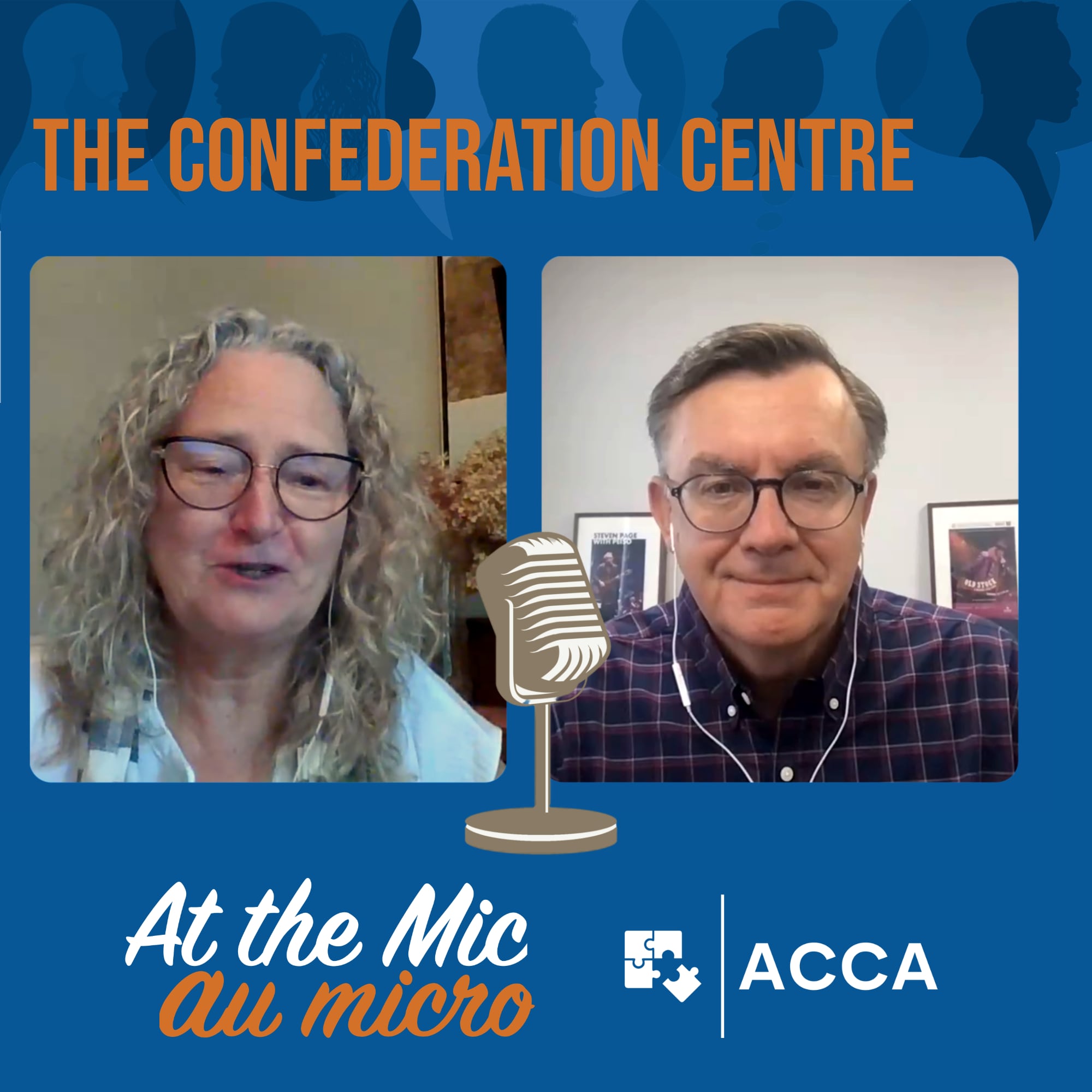VICTORIA:
Over the multi-year stretch of COVID-19, the global pandemic has shaken, threatened, and challenged how the arts, culture and heritage sector operates, and how it sees risk management as an essential tool for optimizing our contribution, our impact. Consultants have been essential to supporting – often leading – the learning curve the sector has experienced.
Hello and welcome to the fourth episode of, “AT THE MIC”, a podcast brought to you by Arts Consultants Canada, l’association des Consultants canadiens en arts. In this edition of AT THE MIC, we bring you a conversation about how risk management has become an essential tool for resilience. Our guest Jerry Smith and moderator Heather Young will share some of their knowledge with you.
ACCA acknowledges the support of the Canada Council for the Arts for this podcast series. / Nous remercions le Conseil des Arts du Canada pour son soutien à cette série de balados.
Active as trainer, consultant, educator and leader, Jerry Smith established the professional theatre training program at Humber College, and their post-diploma certificate program in Arts Administration. His experience includes a wide range of leadership roles on arts and culture boards in the Greater Toronto Area for which he was recognized as Volunteer of the Year and Cultural Champion.
Currently, Jerry serves as a member of the ArtsVote Toronto and ArtsDay at City Hall campaigns, a member of the peer assessment panels for the ArtsVest Program, and the Imagine Canada accreditation program. As a freelance consultant, Jerry has carried out program reviews and strategic plans for MCC, OAC, the Living Arts Centre, Orchestras Canada, Lakeshore Arts, Clay and Paper Theatre, Urban Arts, Neilson Park Creative Centre and HCA Dance Theatre.
Heather Clara Young has worked in arts management for over thirty years. Her experience includes leadership roles with Ontario arts and heritage service organizations, theatre and dance producing companies, facilities, festivals, and community organizations. Her firm Young Associates, founded in 1993, provides full-service bookkeeping and payroll as well as consulting services to not-for-profits and charities, primarily in the arts and culture sector. Heather also teaches in Humber College’s Arts Management program and has taught for the University of Toronto’s Arts Management program. She was the 2012 recipient of the Sandra Tulloch Award for Innovation in Arts and Culture, and a 2004 recipient of Humber College’s Continuing Education Award for Outstanding Academic Contribution. Her unique self-study guide, Finance for the Arts in Canada, will have its second edition published in 2023 and is a invaluable reference source for cultural organizations.
And now, here are Jerry Smith and Heather Young….
HEATHER:
We often hear reference to the concept of Risk Management. Is it that simple – “identify risk, manage it?”
JERRY:
If only!
And the vocabulary surrounding risk management includes multiple terms that resonate – but are not exactly interchangeable – such as:
Strategic Planning / Management;
Contingency Planning / Management;
Continuity Planning or Business Management, for example
HEATHER:
All of which are forms of Project Planning / management, right?
JERRY:
Yes.
Short form:
Risk management is about how to manage, mitigate and minimize the negative impact of identifiable risks in the future. (Sorry – there’s no such thing as risk free.)
Let’s lay out a strategy for this conversation.
Let’s start with WHAT it is – explore some definitions / terms, clarify the benefits of risk management;
then explore WHO it concerns, who needs to be engaged; then
WHY we need to pay attention, what’s in it for your company; and
WHEN in our operating cycle we need to pay attention,
WHERE in the organization’s structure we look, and see where that takes us.
Does that make sense for you?
HEATHER:
A map! One that allows us to stop along the way to explore the unique views as we travel.
JERRY:
Totally.
Consider how you might respond to a client who asks the following question.
“Why should we develop a risk management plan? We already have a strategic plan. We know where we are planning to go. We spent days / weeks with our leadership, governance and staff; we carried out an in-depth SWOT analysis, and built consensus around that plan.
HEATHER:
Well, if someone asked me that question, I’d want to establish the limits of strategic planning. So, a strategic plan is based on the principle that:
* you make strategic decisions about strategic directions – you reconfirm the organization’s mission / vision / mandates / values
* you specify your goals – where you plan to be in 3 / 4 / 5 years
* you determine the most appropriate strategies – such as Programming, HR, Revenue Development, etc.
* you develop a timeline
* then, you work the plan.
JERRY:
That’s the idea.
HEATHER:
Where does Risk Management come in?
JERRY:
This is where much confusion begins. A strategic plan is visionary and directional, maybe even transformational. You have clarified – reconfirmed – who you are; you have a solid understanding of where you are (better known as environmental scan), and collectively you have determined a goal, a destination of what you will look like 3 / 4 / 5 years in the future.
You and your leadership team then execute the tactical steps that your strategic plan has determined will get you there, step by step.
And each year the management team – or, at least, those with authority and skills in what the plan directs – work the plan. In each cycle you review your progress. You tweak the steps, based on progress, and mindfully follow the plan.
However:
How many organizations’ 2020 strategic plans included the following, “Respond to a global pandemic, where governments MANDATE your halls and galleries are closed, where your performers are laid off, as are most of your staff, where audiences and supporters are fearful for their lives to leave the safety of their home, because almost 50,000 Canadians will have died;” and that this could last for three or more years?
At the grassroots level, virtually nobody predicted that risk, that catastrophic risk. Nobody in the arts had a plan for something that impactful!
HEATHER:
COVID has certainly called the norms of planning into question. National, international, and global crises are extraordinary – but arts organizations need to manage a whole world of risks every day. Can we propose a working definition of Risk Management?
JERRY:
There’s a marvellous source I have dipped into over recent years, entitled Risk Management Toolkit, produced by CREATIVE NZ, the Arts Council of New Zealand. For them:
“Risks are
uncertain
future events
that could impact on the organization’s
ability to achieve its objectives.”
HEATHER:
So, even with a strategic plan, we still might need a Plan B – or B1, B2, B3….
Metaphorically – Rather than the beam of light that your strategic plan produces to guide you to where you want to go, a risk management plan is more like a prism that bends the light to help you be prepared to respond in ANOTHER way to any SURPRISES.
JERRY:
And, like any plan, its greatest value is that it has allowed you to prepare before the surprises happen. It’s an organized, thought-out way to address risk, to enable us to be better positioned to reduce the likelihood of harm, from… whatever!
Let’s take a practical example – succession planning.
The largest, single, most impactful risk cultural organizations typically face is a leadership change for either the top paid position (variably called Executive Director / Director / Curator / General Manager / CEO, or Artistic Director) or the top volunteer position (including the Chair / President).
A strategic response to this challenge is generally referred to as Succession Planning; having in place an action plan to help the Board and staff to maintain stability while everything seems to be shifting with the departure of a key leader.
Succession planning needs to be much more than a panic response linked to the potential – or the imminent reality – of finding a successor. Succession planning should be a mind-set, an ongoing process of risk assessment and contingency management for the unplanned – or planned – points of crisis that organizations face on an ongoing basis.
A survey carried out for the PASO Coalition (the Provincial Arts Service Organizations of Ontario) looked at the potential for an incumbent Executive Director to leave within a year. Although that particular survey focused on ASOs, it developed some ideas useful to all arts organizations evaluating the risks associated with a leadership change, and looking through that “prism” of possibilities.
Might the workload / compensation balance be a disincentive? (So, should we re-evaluate our pay scale or our job descriptions?)
How about the degree of specialization required? (Could we work with a generalist, or do we need to recruit for specific expertise?)
How large do you feel your pool of qualified candidates might be? (Is there a chance to recruit from within? Or might you need to undertake a national or even international search?)
All of these questions should be addressed as aspects of risk management within succession planning. Does that help make the process clearer?
HEATHER:
Yes, that’s a great example for illustrating the range of possibilities – Plans B1, B2, B3, etc. – that leadership might need consider, to come up with a strong succession plan.
Given all of that, WHO needs to pay attention to the issues, who needs to be involved in developing a risk management plan? Is this a one-size-fits-all approach?
JERRY:
As with much of our sector’s work, we live in a split world, where we need to balance the imperatives of internal and external factors.
We do need to recognize and address the needs of stakeholders that are outside of our companies, outside our control – the list can be long, but would include such macro elements as the economy (and current inflation), population distribution and demographics (for example, the shift in seniors’ population as the boomers age), the current loss of comfort about large groups of people gathering as a community – for performances, exhibitions; for board and committee meetings; and so on. You cannot control these factors, but you can try to manage them.
As well, we must consider the stakeholders inside our sphere of control – our board / committees, management team, staff, artists / performers / creators, volunteers.
Additionally, we need to address the needs of those stakeholders not exactly under our control but within our sphere of influence – audience / visitors; advertisers / media / sponsors, funders, members / subscribers, the public / community, contractors / suppliers, local / provincial / federal government – and their funders / funding agencies.
Given the range of people with a stake in an organization’s success, and the range of risk factors to be considered, a team effort is definitely the way to go.
Your risk management team should probably be somewhere between three and eight individuals. In a small / smaller company, it makes sense to engage all your internal stakeholders – board / committee / staff / key volunteers; in larger organizations, a committee / task force or the management team may identify and rate risks.
Either way, involve those with the knowledge and skill you need.
For an organization developing its first risk management plan, engaging an “outside eye” – a consultant – might be a productive move. The ACCA membership includes many seasoned practitioners able to help guide the process.
HEATHER:
So, we’ve addressed one common risk that all organizations face: succession planning. The first step of a risk planning process is identifying the risks for which you need to plan.
Obviously, any number of bad things could happen, some of them more likely and others less likely! I could walk out of my home and be hit by a falling asteroid! But I’m not planning for that eventuality!
Can you give us some direction on the types of risks managers should focus their attention on?
JERRY:
Some key considerations leap to mind.
Staff, board and key volunteer changes, as we’ve noted.
Financial risks arising from programming and other decisions, as well as external forces such as the economy, inflation, funding policies, etc.
Operational risks ranging from plumbing leaks to slip-and-fall accidents.
Obviously, everyone’s mind has been very much on COVID – and managers might want to consider their potential response to a major public crisis – but as a practical matter, risk management should focus on perils closer to home.
HEATHER:
OK, it’s helpful to have this outline before we jump into a higher level of detail. Let’s do that now. Jerry, what approaches can we take to quantify or describe or analyse risk?
JERRY:
Simple question, but not a simple answer.
First, keep the following two ideas at the forefront of your mind as we work our way through the process of risk management. The first is PROBABILITY, the second is IMPACT.
With PROBABILITY, we need to determine the degree of likelihood that something might happen in the future.
It could be HIGH (likely to happen, we have strong exposure, external forces you do not control), or is it MEDIUM (could possibly happen, we are exposed to the risk, and there are external factors that make managing the risk difficult – but not impossible); or is it of LOW probability (unlikely to occur, and minimal exposure.)
Concurrently, we need to be able to score the possible IMPACT of these risk elements,
which could also be HIGH (extremely serious, extended over time, and requiring intervention from the Board), or is it MEDIUM (serious, but perhaps a shorter-term or less consequential disruption, which can be handled by management); or is the impact LOW (minimal impact on the company, could be handled by staff with some management attention.)
So the two factors of probability (high, medium, low) and impact (also high, medium, low) give us a grid that we can use to aid our assessment of the level of risk of individual factors.
HEATHER:
Let’s take an example. An organization has an opportunity to present an exceptional show. It’s brilliant, and right within the core of their mandate – but it’s also challenging, to the degree that a general audience is unlikely to attend. This is something exceptional, with appeal for only a narrow band of patrons.
Opportunities of that nature come along rarely, so the PROBABILITY is low. If the company accepts the challenge, they know its possible IMPACT is high – both in terms of finance, where the repercussions will almost certainly be negative, and in terms of reputation, where the repercussions have the potential to be extremely positive.
What risk management strategies might this company adopt for deciding whether to proceed?
JERRY:
There are four core strategies at management’s disposal for managing any sort of risk.
First, AVOID the risk – in your example, by turning down the opportunity
Next, REDUCE the risk – perhaps in this case by reaching out to sources of financial support – a project grant, a sponsor, or donors
Then, SHARE or TRANSFER the risk – by co-producing with a collaborator
And finally, ACCEPT the risk, see it as an opportunity
All four strategies – AVOID – REDUCE – SHARE or TRANSFER – and ACCEPT – may not be viable in every situation – but those are the ones managers need to consider.
I’ll give you a few quick examples to consider.
Say that your lead corporate sponsor informs you that the contribution you had counted on for the season’s opening production or exhibition is no longer available.
We know that corporations often want to spread their support around – so we might classify losing a sponsor as a risk with both a HIGH probability of occurring, and a HIGH impact if it did occur.
In a slightly different scenario, the same donor / sponsor might give you a heads-up that next season will be the end of their support. Still HIGH probability but LOWER impact, because now you have time to look for alternatives.
Once you’re in the sponsorship world, there’s no way to AVOID this peril. Some day, it will happen to you! But you can REDUCE the risk by creating a “ladder” of support, where you have a sole lead sponsor (perhaps naming), at a top price, followed by several secondary sponsors (perhaps for each show or exhibition), again followed by lower rungs. The design concept is all about succession: the next one is already in place, positioned to move up.
You could SHARE the risk, again, through a collaborator. Or, you could simply ACCEPT the risk as something you may need to deal with, within the scope of your operating budget.
Another example.
Say you’re producing an outdoor event. There’s a high PROBABILITY that, one year or other, bad weather will cause you problems – and the IMPACT could turn out to be low, medium, or high.
There’s no way to AVOID weather risk when you’re producing outdoors. But, you can REDUCE the risk by developing a rainy-day plan, and perhaps a separate plan for thunder and lightning. In this example, you can TRANSFER the risk to an insurance company, by paying for cancellation insurance. And, of course, by working outdoors at all, you have implicitly ACCEPTED that this sort of thing is likely to happen sooner or later.
HEATHER:
So far, we’ve looked at WHAT risk management is and WHO needs to pay attention. As a manager, WHERE across the organization do I need to look; what functions are most important – in terms of both probability and impact?
JERRY:
I would start with the list of factors that probably should have driven your strategic plan. Again, different stroke for different folks! This list won’t apply to everyone, but offers good logic for both your strat plan and your risk management plan.
STRATEGIC: All those functions that cover the entity, the company, the organization – your mission / vision / mandate / values; your core goals / objectives. Are you a so-called “anchor organization;” or are you an alternative, cutting-edge risk-taker?
COMPLIANCE: Those responsibilities informed / driven by your by-laws and other internal policies such as your employee manual – as well as the policies and codes of practice determined by outside bodies – Canada Revenue Agency; generally accepted accounting principles, public health regulations; HR legislation.
FINANCIAL: Do you have strong systems in place to manage transactions and produce accurate reporting? Do you have leaders at the staff and board levels with strong competencies in accounting and finance? Do you generate a balanced diversified stream of revenues? Do you have savings to fall back on, should problems occur?
OPERATIONS: the whole range of operations and administration functions that sustain your status as a going concern; do you rent, lease, own your facility? do you tour, run outdoor seasonal events; are your staff full-time, contract or seasonal?
REPUTATION: sometimes called goodwill, or brand value
PROGRAMMING: the raison d’etre, the whole ball of wax. This may be at the bottom of my list, but I see it as the foundation.
To summarize: strategic, compliance, financial, operations, reputation, programming
HEATHER:
And WHY do this. What makes the benefit of Risk Management planning worth the effort?
JERRY:
Good risk management practices will help your organization reduce uncertainty by anticipating and preparing for both the probability and the impact, buffering the chance that something will go wrong and reducing the impact if it does go wrong.
Remember, the risk can be quantified or described as a combination of the probability and the impact – and how they can magnify each other.
The healthiest organizations are those who have done the homework – identified their particular risks, evaluated probabilities and likely impacts, considered best options, measured the potential costs, and mapped out their best path forward should a peril come to pass.
But it doesn’t stop there! It’s important to document that work, share it with those who are expected to take action when a problem arises – and then to revisit risk planning periodically to keep it up to date.
It’s ultimately about avoiding crisis and improving your performance.
HEATHER:
So, good Risk Management practices can reduce the risk of losing money and improve the financial health of the organization.
JERRY:
Can we take cash flow planning as an example?
HEATHER:
Sure. That’s my bailiwick! It’s a safe bet that the vast majority – if not all – professional arts organizations in Canada will have an operating budget. That is, a financial policy document that sets out targets for revenue generation and spending for the next year.
However, not all organizations use a cash flow plan. The distinction is that cash flow focuses entirely on money flowing through the bank account. It’s a detailed operational risk planning tool, often updated monthly.
Adding the dimension of TIME helps managers to predict WHEN problems might arise. It also helps managers look at the interaction between regular flows of revenues and expenses, and one-off or occasional items.
An excellent example of this is payroll – arguably both the largest and most important expense for any organization. Becoming unable to meet payroll is a significant problem! And yet, to cover their payrolls, arts organizations rely on periodic sources of revenues such as grants, and sources that can be hard to predict, such as ticket sales and donations.
A well-structured and diligently maintained cash flow forecast is an excellent tool for putting all of these pieces together, identifying risks, and preparing contingency plans.
JERRY:
A cash flow plan is something a financial manager can use as part of their day-to-day work to shape what they can, in order to REDUCE the impact of tight spots, and perhaps AVOID them altogether.
HEATHER:
That sounds like a happy thing for staff! I see an HR advantage to risk management as well. I know very well that financially secure organizations are often happier places to work.
JERRY:
Indeed! Strong risk management practices can help organizations avoid burn-out and improve job satisfaction. Fire-fighting takes a lot more energy than fire prevention! When crises are unlikely, people can focus on the positive aspects of their work – building, creating, moving ahead.
HEATHER:
Let’s talk about WHEN risk management planning should happen. Between a Strategic Plan and a Risk Management Plan, should one come before the other?
JERRY:
Let me answer this way.
Every form of the term, plan or planning, is a verb, an “action word,” not a noun, a “person, place or thing.”
I have worked with clients who really only wanted to be able to tick that box on the funder application, “Do you have a strategic plan?” Yes, we have a strategic plan, right there – our strategic plan on the top shelf (aka SPOTS).
HEATHER:
So, planning is an activity – a mindset – not one-and-done process or event.
JERRY:
Maybe you contracted a consultant (probably a member of the ACCA – Arts Consultants Canada) who guided you through a detailed, extensive process that resulted in a document – your strategic plan.
That’s fantastic – good for you! But, planning is much more than that document. To really work for your organization, it needs to be dynamic – it needs to be a vital PROCESS.
So, although you might undertake a strategic planning exercise every 3 / 4 / 5 years, what’s needed to lift it down from the shelf and off the page is an annual review – supported / reviewed of course by board and staff. Planning is a verb! It’s all about action, what you plan to do NEXT.
Now, I do see some logic that says a strategic plan is the optimal first step in the sequence. A strat plan clarifies mission, direction, outcomes, and metrics in your ideal view of the company. It is the prediction of your best case scenario.
HEATHER:
But we don’t always have the best case, do we?
JERRY:
And that’s where a risk management plan comes to the forefront. As you operationalize all of the steps in your strat plan, you – and your team – need to have gone through the process of asking yourself, “What happens if …? What are my alternatives?
Using the framework of probability and impact, and the shopping list of functions, you and your team have brainstormed, have determined where in your plan are the riskiest, most impactful pitfalls, and what are your alternatives.
HEATHER:
And then, once we’ve done that, are we resilient?
JERRY:
The Arts Council of England, in 2018, in its review “What is Resilience Anyway,” “drew a distinction between survival resilience (bouncing back to your previous state) and the richer more fruitful idea of adaptive behaviour (bounce forward to a new, adapted state).”
HEATHER:
So, you are likening risk management to a form of adaptive behaviour, a bouncing forward?”
JERRY:
Yes. Look at how we responded to COVID.
We’ve been through a crisis, and we’ve lost a lot, it’s true – but I cannot imagine any organization in the arts, culture, heritage sector today forgetting the lessons of pivoting – programs online / streaming / hybrid; working from home / remote; distancing in lobbies / galleries / halls; masking mandates.
As a sector, we have faced and are facing the greatest risk of our generation. We’re proving our ability to adapt.
If one of the benefits of COVID is a greater engagement with risk planning as a best practice, that’s a benefit that will make us stronger for years to come.
HEATHER:
Indeed! Thank you, Jerry.
JERRY:
And, thank you, Heather
VICTORIA:
And that wraps up our fourth edition of AT THE MIC, a podcast of Arts Consultants Canada. For information on ACCA and our members, please check us out online at artsconsultants.ca. To send us feedback or questions on anything you hear in this podcast series, please email us at
[email protected]. and remember to check our show notes in this podcast for links mentioned during the program.
Et noter bien que quelques épisodes a venir seront en français et nous offrons accès à un service de traduction de ne rien manquer!
Thank you so much for joining us on AT THE MIC. Remember to subscribe to this podcast at Apple Podcasts, Google Podcasts, Spotify, or wherever you find your favourite podcasts. Until next time, and again thanks for listening. À la prochain.






